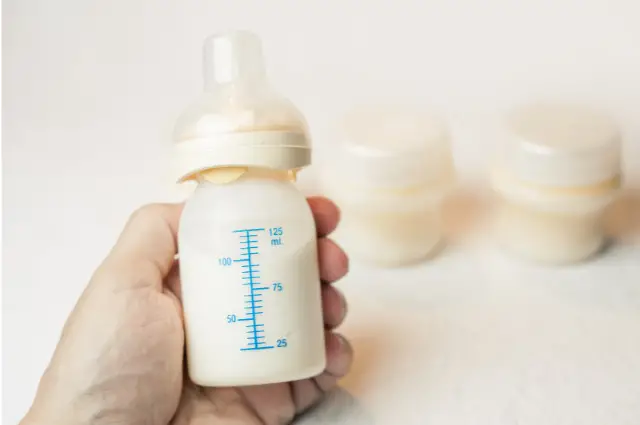Just like you can’t put a hot glass jar directly into a refrigerator to cool it down for the risk of shattering, you can not mix warm milk with cold milk together. Both the cold and the warm Breast milk has to be at the same temperature before mixing. You may ask “why does breast milk have to be the same temperature before mixing? The reason is that the enzymes in warm milk are active and will be a favorable condition for the growth of bacteria in the cold milk. This is because the temperature in the cold milk rises too quickly when the warm milk is introduced. A change in temperature such as this must always be gradual, never instant.
Hey! By the way… any links on this page that lead to products on Amazon are affiliate links and I earn a commission if you make a purchase. Thanks in advance – I really appreciate it! .
However, the question that begs for an answer is “can babies drink cold breast milk?”. Although, it is better to feed your baby warm milk, if the time is not there and the baby is hungry, you can feed the baby cold breast milk. If you are looking for faster ways to warm up cold breast milk, check out the ones below.
How To Warm Breast Milk
In A Warm Water Bath
Thinking of mixing warm and cold breast milk? The process is simple. Fetch some warm water in a bowl or basin, then dip your breast milk bottle into it, ensuring that the cap is well above the water level. This way, the milk warms up and thaws gradually, making the milk still safe for consumption.
In A Refrigerator
Here, you bring the breast milk bottle out of the freezer and transfer it to the refrigerator. Since both conditions are cold, there doesn’t seem to be a significant temperature drop, and the milk thaws out safely.
Under Running Water
You can also hold the milk bottle under cold running water in the beginning. Then continue by turning the faucet, gradually making the water warmer as you go. This process also ensures that the milk gains temperature gradually.
Now that we’ve discussed safe ways to warm up breast milk, let’s find safe ways to mix breast milk at different temperatures.
Methods To Mix Breast Milk at different temperatures
Don’t Mix At All
When you have a baby with special needs, a little tot, a preemie, or a sick baby then the best way to go is to never consider mixing cold breast milk with warm. You need to seal every batch of pumped milk immediately after pumping and refrigerate or freeze at once. You may end up introducing contaminants into the milk if you don’t have a sterile environment. With a risk so high, it’s best to not mix at all.
Adding Warm Milk To Room Temperature Milk
While pumping at a sitting, it is possible to have a first and a second batch of breast milk. Before expressing the next batch, the first batch may have spent some time on the counter. Here, experts have shown that there are risks involved when adding one to another.
Adding Warm Milk To Defrosted Milk
Thinking of mixing warm breast milk with cold breast milk? If the warm breast milk is freshly expressed milk, it is most advisable to feed your baby that milk first as it is very beneficial. You can then top up with the defrosted milk from which leftovers should be discarded.
Adding Warm Milk To Frozen Milk
Adding warm milk to frozen milk follows a process called layering. Layering is done by putting the warm milk in the refrigerator first to reduce its temperature. The frozen milk is also brought into the refrigerator and once they are both nearly equally cool, you pour the formerly warm batch into the frozen one. This is a better process of mixing cold and warm breast milk.
Adding Warm Milk To Refrigerated Milk
Before mixing warm and cold breast milk, you need to cool the warm milk in the refrigerator first. When it is cool enough, you add it to the other batch provided both batches were pumped on the same day. You could also mix warm and cold breast milk by warming up the refrigerated milk using any of the warming techniques discussed above and then mix the two.
How To Know That Your Breast Milk Has Gone Bad
The smell of spoiled breast milk is similar to those of cow milk with only a few exceptions.
Foul Smell
The easiest way to know that your milk has gone bad is to take a whiff. If it has that distinctive foul smell experienced with cow milk. Then sure you should discard it. Do not be alarmed by a metallic or soapy smell which experts have shown is due to enzymes produced by the mother’s body. Besides, your baby will most likely drink the milk with no fuss. Nevertheless, if your baby refuses the milk when it has a soapy smell, you can scald it in an open pan for a few minutes, cool, and store. This helps to reduce the soapy sensation.
Layers That Won’t Mix
Breast milk separates into layers when in storage, but those layers usually mix well when you swirl gently. However, when the milk has gone bad, it becomes difficult for those layers to mix and reform a homogenous mixture. Once you notice this in your milk, it’s a sign that it has gone bad.
Sour Taste
This is also a very easy test for spoilage. You just have a little test of the milk yourself and if it tastes sour, then it’s got to go.
Causes Of Breast milk Spoilage
Breast milk spoilage is usually caused by problems in storage or pumping. Causes include:
1. Improper storage: this includes placing the milk in front of the fridge where the temperature fluctuates instead of the back, mixing milk at different temperatures, refreezing defrosted milk, and changing the storage unit too often.
2. Improper sealing: breast milk should be sealed tightly in an appropriate milk container after collection. If this isn’t done, it allows for contaminants to get into the milk and initiate the growth of bacteria.
3. Faulty accessories: try to get pumping gear that fits well on the nipple and does not cause any discomfort. Consult your pediatrician if you don’t know what the best type of accessories is for your baby.
There you have it – the answer to the question “why can’t you add warm breast milk to cold breastmilk”. mixing warm and cold breast milk means bringing them to the same temperature. Either by warming or cooling one to the temperature of the other. Note that it is better to cool the warm batch than to warm the cold batch before mixing because breast milk loses some of its antibodies when warming. Remember, after mixing, the entire mixture is as old as the first milk pumped into that bottle.

